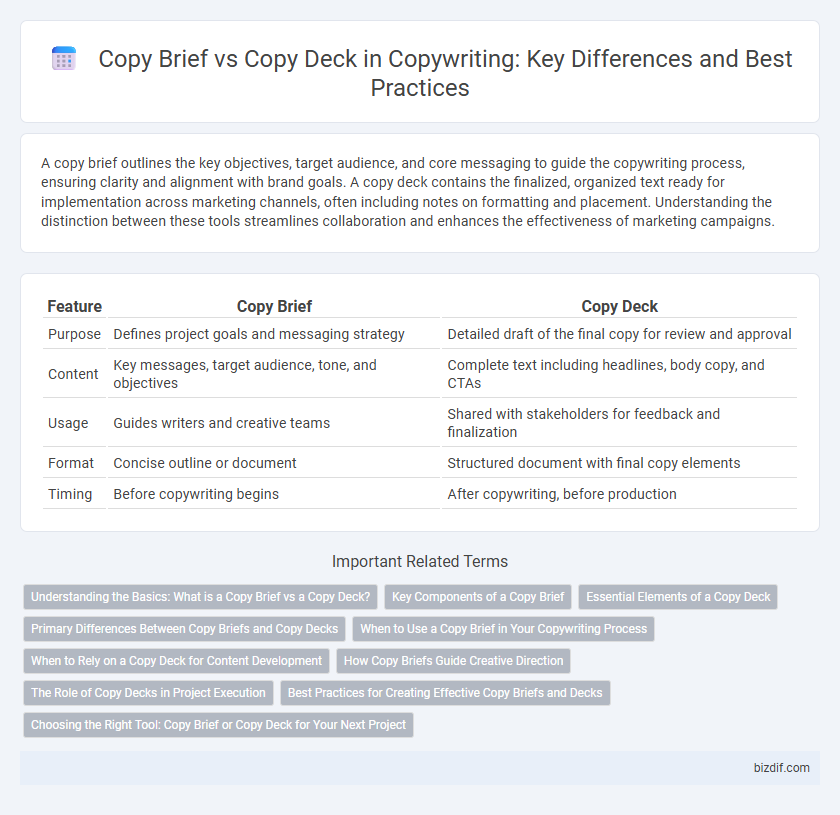A copy brief outlines the key objectives, target audience, and core messaging to guide the copywriting process, ensuring clarity and alignment with brand goals. A copy deck contains the finalized, organized text ready for implementation across marketing channels, often including notes on formatting and placement. Understanding the distinction between these tools streamlines collaboration and enhances the effectiveness of marketing campaigns.
Table of Comparison
| Feature | Copy Brief | Copy Deck |
|---|---|---|
| Purpose | Defines project goals and messaging strategy | Detailed draft of the final copy for review and approval |
| Content | Key messages, target audience, tone, and objectives | Complete text including headlines, body copy, and CTAs |
| Usage | Guides writers and creative teams | Shared with stakeholders for feedback and finalization |
| Format | Concise outline or document | Structured document with final copy elements |
| Timing | Before copywriting begins | After copywriting, before production |
Understanding the Basics: What is a Copy Brief vs a Copy Deck?
A copy brief is a strategic document that outlines key messaging, target audience, objectives, and tone to guide copywriters in crafting effective content. A copy deck is the finalized, organized document containing the actual written copy, formatted for review, approval, and implementation across marketing channels. Understanding the distinction between a copy brief and a copy deck enhances workflow efficiency and ensures alignment between strategic intent and executed content.
Key Components of a Copy Brief
A Copy Brief outlines the project's objectives, target audience, key messages, tone, and call to action, serving as a strategic roadmap for copywriters. It includes essential components such as brand guidelines, customer insights, competitive analysis, and desired outcomes to ensure alignment with client goals. Unlike a Copy Deck, which contains the finalized text for production, the Copy Brief focuses on the foundational elements that guide the creative process.
Essential Elements of a Copy Deck
A copy deck serves as the definitive document where all finalized copy is compiled, formatted, and organized for seamless handoff to designers and developers. Essential elements include clearly labeled headlines, body text, call-to-action (CTA) phrases, and notes on tone or style to ensure consistent messaging across marketing channels. Incorporating version control details and client approvals within the copy deck enhances project workflow efficiency and reduces miscommunication risks.
Primary Differences Between Copy Briefs and Copy Decks
Copy briefs serve as foundational documents outlining project goals, target audience, key messages, and tone, guiding the creative process for copywriters and stakeholders. Copy decks are detailed word-for-word drafts of final copy, organized by format and ready for client review or production, ensuring consistency and accuracy across all deliverables. The primary difference lies in the copy brief's strategic overview versus the copy deck's tactical execution of content.
When to Use a Copy Brief in Your Copywriting Process
A Copy Brief is essential at the start of the copywriting process to outline key objectives, target audience, tone, and brand guidelines, ensuring alignment between stakeholders and writers. Use a Copy Brief when planning campaigns, new product launches, or strategic messaging to provide clear direction and prevent miscommunication. This foundational document streamlines project management and saves time by setting precise expectations before drafting begins.
When to Rely on a Copy Deck for Content Development
Rely on a copy deck for content development when detailed content organization and version control are crucial, as it provides a comprehensive document that includes all final copy, notes, and revisions. Copy decks streamline collaboration between writers, designers, and stakeholders by centralizing approved content and annotations, ensuring consistency across marketing materials. They are especially valuable in complex projects with multiple content elements and iterative edits, preventing miscommunication and enhancing workflow efficiency.
How Copy Briefs Guide Creative Direction
Copy briefs provide a strategic framework by outlining key objectives, target audience insights, and brand tone, ensuring the creative team aligns with campaign goals. They serve as a foundation for ideation, setting clear expectations and messaging priorities before copywriting begins. This guidance enhances consistency, streamlines collaboration, and drives more effective and focused creative outputs compared to copy decks, which primarily organize finalized content.
The Role of Copy Decks in Project Execution
Copy decks serve as the detailed blueprint in project execution by organizing finalized copy in the context of design elements and user experience. They provide clarity on tone, style, and messaging, ensuring that all stakeholders, including designers and developers, maintain consistency throughout the project lifecycle. By acting as a central reference, copy decks reduce miscommunication and streamline revisions, ultimately enhancing efficiency and quality in campaign delivery.
Best Practices for Creating Effective Copy Briefs and Decks
Effective copy briefs clearly define target audience, key messaging, tone, and project goals to guide the creative process and ensure alignment with client expectations. Copy decks organize finalized copy versions with annotations, context, and content hierarchy, streamlining collaboration among writers, designers, and stakeholders. Best practices include maintaining concise, actionable information in briefs and ensuring decks are visually structured for easy review and iteration.
Choosing the Right Tool: Copy Brief or Copy Deck for Your Next Project
Selecting the right tool between a Copy Brief and a Copy Deck depends on the project's stage and communication needs. A Copy Brief outlines key objectives, target audience insights, and messaging guidelines, making it ideal for initial strategy alignment. In contrast, a Copy Deck compiles finalized content, including headlines, body copy, and calls to action, serving as a comprehensive reference for designers, developers, and stakeholders during implementation.
Copy Brief vs Copy Deck Infographic

 bizdif.com
bizdif.com